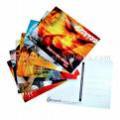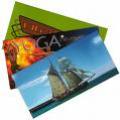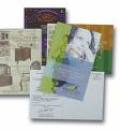
Post Cards Information Directory
|
HISTORY OF POSTCARDS MIDDLE ERA
History Of Postcards - Middle Era
DIVIDED BACK ERA ( 1907 - 1915 )
As of March 1, 1907, the divided back postcard came into circulation. They quickly became more popular because they allowed senders to write the address and the message on the back of the card. The address had to be written on the right side of the back of the postcard while the left side was reserved for writing messages. Postcards from this period are most collectible when they do not have writing on the front. At this time in American history the postcard hobby became a huge public addiction. Publishers printed millions of cards in this era. Most postcards were printed in Germany which was the world leader in lithographic processes. At the height of the countrywide postcard hunger, WWI caused a crash in the hobby. The advent of WWI caused the supply of postcards from Germany to end. Poorer quality postcards came from English and U. S. publishers. The lower quality of printed postcards, recurrent influenza epidemics, and WWI war shortages killed the American postcard hobby. During the war years, the telephone replaced the postcard as a fast, reliable, means to keep in touch.
WHITE BORDER ERA ( 1915 - 1930 )
When imports from Germany ceased in the first World War, the U. S. began printing postcards to fill the void. Unfortunately, this also ended the " Golden Age " of postcards. After WWI, the German publishing industry was never rebuilt. Other European publishers were forced out of the U. S. market by high tariff rates. Most locally available postcards were printed by U. S. publishers during this period. On view postcards, to save ink, a white border was left around the view, and that is why we call them " White Border " postcards. The higher costs of post - war publishing combined with inexperienced labor caused production of poorer quality cards. Movies, as they were, replaced postcards as a visual experience. Higher competition in a rapidly narrowing market caused many publishers to go out of business. On the other hand, real photo postcard publishers enjoyed great success. Various types of rotary drum negative imprints allowed runs of thousands of postcards of a particular image. Roadside postcard racks contained a great variety of these images.
LINEN ERA ( 1930 - 1945 )
In the 1930s, postcard printing in the United States improved. Publishers began using linen - like paper with a high rag content. These types of cards are very popular with collectors today. Of particular interest are Roadside America, Blacks, Comics and Advertising genres.
New American printing processes allowed printing on postcards with a high rag content. This was a marked improvement over the White Border postcard. The rag content also gave these postcards a textured feel to them. They were also cheaper to produce and allowed the use of bright dyes for image coloring. They proved to be extremely popular with raodside establishments seeking cheap advertising. Linen postcards document every step along the way of the building of America's highway infra - structure. Most notable among the early linen publishers was the firm of Curt Teich. The majority of linen postcard production ended around 1939 with the advent of the color chrome postcard. However, a few linen firms, mainly southern, published well into the late 1950s. Real photo publishers of black & white images continued to have success.
Faster reproducing equipment and lowering costs led to an explosion of real photo mass produced postcards. Once again a war interfered with the postcard industry ( WWII ). During the war, shortages and a need for military personnel forced many postcard companies to reprint older views when printing material was available.
About The Author:
Peter Dobler is a veteran in the IT business. His passion for experimenting with new internet marketing strategies leads him to explore new niche markets.
Read more about his experience with post cards; visit http://post-cards.tip4u2.com
 |
 |
 |
A QUICK OVERVIEW OF POSTCARD COLLECTING
POSTCARDS THAT ARE WORTH A PRETTY PENNY
HISTORY DESCRIPTION OF VINTAGE POSTCARDS
THE HISTORY OF EASTER POSTCARDS
More Post Cards Reviews
... together. Architecture is another aspect of why people collect postcards. Buildings today have changed from those of the past which you could see using these architectural postcards. Also, you could use architectural postcards to see if any important people of the day lived in a certain town Historical ...
HISTORY DESCRIPTION OF VINTAGE POSTCARDS
... photographic paper. With the size and weight of postcards with a postcard back. There are many postcards that reproduce photos by various printing methods that aren't " real photos. " Instead are the same methods used to reproduce photos in magazines and newspapers. The best way to tell the difference ...
... company. The Ur - Leica was a compact camera based on the idea of reducing the format of negatives and enlarging them later after they had been exposed. This small portable device made nude photography in secluded parks and other semi - public places easier. It was a plus for amateur erotica. Artists ...
HISTORY OF POSTCARDS...EARLY ERA
... Undivided Back Era postcards, writing on the front is acceptable, not usually decreasing the condition grade of these cards but there are exceptions to every rule. The publishing of printed postcards during this time doubled almost every six months! In addition, European publishers opened offices in the ...

|
| Copyright © 2006-2012 Internet Marketing Tools, All Rights Reserved |